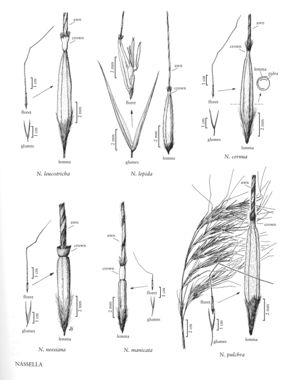Difference between revisions of "Nassella manicata"
FNA>Volume Importer |
imported>Volume Importer |
||
| (4 intermediate revisions by 2 users not shown) | |||
| Line 17: | Line 17: | ||
-->{{Treatment/Body | -->{{Treatment/Body | ||
|distribution=Calif. | |distribution=Calif. | ||
| − | |discussion=<p>Nassella manicata is native to Ecuador, Chile, Argentina, and Uruguay, growing on the foothills of the Andes Mountains. It is established in three California counties, growing in disturbed sites, including grazed meadows and old gold tailings. It has also been recorded from Mississippi; it is not known whether the Mississippi population has persisted.</p><!-- | + | |discussion=<p><i>Nassella manicata</i> is native to Ecuador, Chile, Argentina, and Uruguay, growing on the foothills of the Andes Mountains. It is established in three California counties, growing in disturbed sites, including grazed meadows and old gold tailings. It has also been recorded from Mississippi; it is not known whether the Mississippi population has persisted.</p><!-- |
| − | --><p>Nassella manicata resembles N. leucotricha and N. pulchra. It differs from both in its shorter florets and more strongly developed crowns. It was misidentified as Nassella formicarum (Delile) Barkworth in the Jepson Manual (Barkworth 1993).</p> | + | --><p><i>Nassella manicata</i> resembles <i>N. leucotricha</i> and <i>N. pulchra</i>. It differs from both in its shorter florets and more strongly developed crowns. It was misidentified as <i>Nassella</i> formicarum (Delile) Barkworth in the Jepson Manual (Barkworth 1993).</p> |
|tables= | |tables= | ||
|references= | |references= | ||
| Line 27: | Line 27: | ||
-->{{#Taxon: | -->{{#Taxon: | ||
name=Nassella manicata | name=Nassella manicata | ||
| − | |||
|authority=(E. Desv.) Barkworth | |authority=(E. Desv.) Barkworth | ||
|rank=species | |rank=species | ||
| Line 34: | Line 33: | ||
|basionyms= | |basionyms= | ||
|family=Poaceae | |family=Poaceae | ||
| − | |illustrator=Linda | + | |illustrator=Linda Ann Vorobik |
| + | |illustration copyright=Utah State University | ||
|distribution=Calif. | |distribution=Calif. | ||
|reference=None | |reference=None | ||
| Line 40: | Line 40: | ||
|publication year= | |publication year= | ||
|special status= | |special status= | ||
| − | |source xml=https:// | + | |source xml=https://bitbucket.org/aafc-mbb/fna-data-curation/src/200273ad09963decb8fc72550212de541d86569d/coarse_grained_fna_xml/V24/V24_237.xml |
|subfamily=Poaceae subfam. Pooideae | |subfamily=Poaceae subfam. Pooideae | ||
|tribe=Poaceae tribe Stipeae | |tribe=Poaceae tribe Stipeae | ||
Latest revision as of 16:22, 11 May 2021
Plants perennial; cespitose, not rhizomatous. Culms 40-80 cm tall, 1.5-2.5 mm thick, erect, internodes glabrous; nodes 2-3, pubescent. Sheaths glabrous; collars mostly glabrous, with tufts of hair at the sides, hairs 0.5-1 mm; ligules 0.1-0.3 mm, glabrous, truncate; blades 12-25 cm long, 1.5-2.5 mm wide, flat to convolute, pubescent. Panicles 10-20 cm, open; branches 1-3 cm, ascending to somewhat spreading, scabridulous, with 1-8 spikelets; pedicels 1-8 mm, pubescent. Glumes subequal, 10-15 mm long, 1.5-2 mm wide, narrowly lanceolate, 3-veined, keeled, keels scabrous; florets 6-8 mm long, 0.9-1.1 mm wide, terete, widest near or slightly above midlength; calluses 1.5-2.5 mm, sharp, strigose; lemmas papillose-tuberculate, constricted and purplish below the crown, midveins and exposed marginal veins pubescent over the proximal 2/3, glabrous between the veins at maturity; crowns about 1 mm long, about 0.5 mm wide, conspicuous, more or less straight-sided, purple, rims with 1-1.5 mm hairs; awns 30-50 mm, clearly twice-geniculate, terminal segment straight; anthers 3-4 mm in putatively chasmogamous florets, 0.3-0.5 mm in cleistogamous florets, both ranges sometimes present within a panicle. Caryopses about 3 mm. 2n = unknown.
Discussion
Nassella manicata is native to Ecuador, Chile, Argentina, and Uruguay, growing on the foothills of the Andes Mountains. It is established in three California counties, growing in disturbed sites, including grazed meadows and old gold tailings. It has also been recorded from Mississippi; it is not known whether the Mississippi population has persisted.
Nassella manicata resembles N. leucotricha and N. pulchra. It differs from both in its shorter florets and more strongly developed crowns. It was misidentified as Nassella formicarum (Delile) Barkworth in the Jepson Manual (Barkworth 1993).
Selected References
None.
